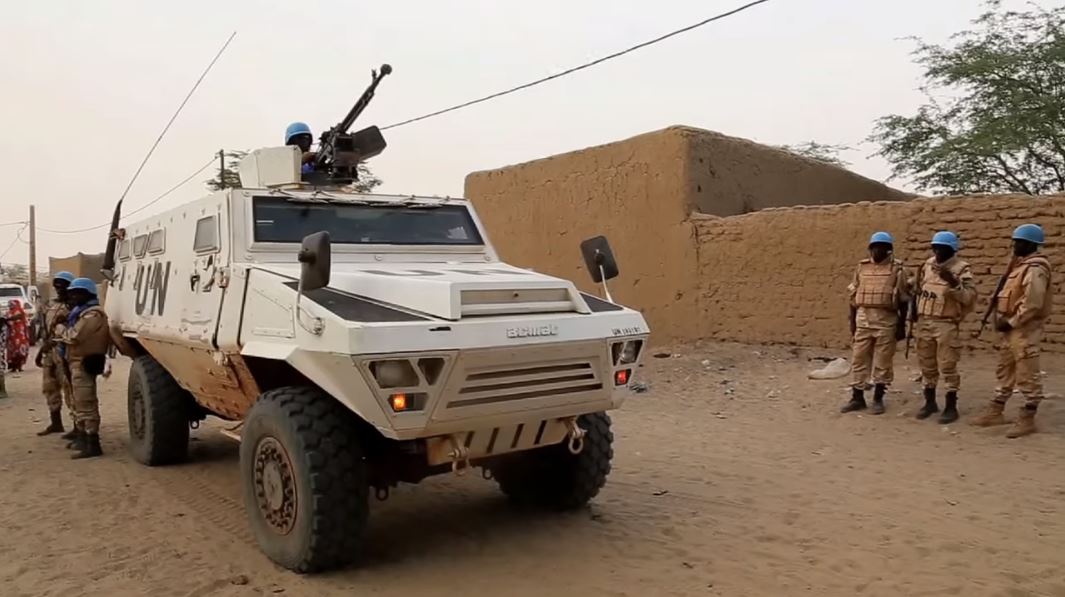
Malian Coup Leader Faces Challenges Reconquering Kidal
By Jacob Zenn

MINUSMA Goundam 2015
“I am sending planes to bomb their positions and the army will return to Kidal….”
Over the past half-decade, Malian insurgents, and especially the al-Qaeda-affiliated Group for Supporters of Islam and Muslims (JNIM), have expanded their influence across northern Mali and have begun to control key towns in that region, such as the primarily Tuareg-inhabited Kidal. However, according to the excerpted article from the French-language publication togotimes.com, interim president of Mali, Assimi Goïta, has vowed to reconquer Kidal. While the Malian Army may be more powerful than JNIM, the reconquest and government rule of Kidal raises questions about heavy-handed tactics the Malian Army will employ and whether the Army will cooperate with Russia’s Wagner Group,[i] which has aided it in counterterrorism for the past year.[ii]
At the same time, Goïta is rejecting any negotiations with the Coalition of the Movement of Azawad (CMA), [iii] which seeks autonomy for Tuareg regions of northern Mali. Unlike JNIM, which is explicitly jihadist and unwilling to compromise with the state, the CMA accepts Mali’s legitimacy as a nation-state. In his speech, Goïta stated he would send the Army to liberate any area of the country that disassociates from being “Malian,” which hinted at little room for accommodation of the “Tuareg” CMA. Goïta’s threats to send warplanes to bomb Kidal alongside his partnership with Wagner suggest that an excessively harsh military operation may be underway and that it could alienate civilians in northern Mali from government rule and ultimately favor recruitment into JNIM or the CMA.
Less than two weeks after Goïta’s speech, discussed in the excerpted article in French-language media agenceecofin.com, the UN Multidimensional Integrated Stabilization Mission in Mali (MINUSMA) withdrew from its base in Aguelhok, Kidal region following demands from Goïta and other Malian coup leaders.[iv] However, Goïta condemned MINUSMA for its accelerated exit from Aguelhok due to intensified combat with JNIM and not transferring the base or weapons to the Malian Army. Rather, MINUSMA destroyed them so they would not fall into the hands of JNIM, which ultimately took over the Aguelhok base for a short period of time.[v] The rapid MINUSMA withdrawal and JNIM advances in its aftermath will make Goïta’s realization of his promise to reconquer and hold Kidal more difficult, even as his political credibility rests on it. On top of this, cooperation with Wagner could result in the alienation of northern Malian civilians from the government. Further, the chasm between Goïta and the CMA make any political resolution in northern Mali less likely as well.
Sources:
“Ce message important d’Assimi Goïta au CMA, le JNIM et leurs llies (This important message from Assimi Goïta to the CMA, JNIM and their allies),” togotimes.com (French-language publication edited in Togo that provides commentary on current affairs in Francophone African countries), 10 October 2023. https://togotimes.info/2023/10/10/mali-ce-message-important-dassimi-goita-au-cma-le-jnim-et-leurs-allies/#google_vignette
The reconquering of Malian territory will not be a subject to discussion. Regarding this point, the latest transitional president Assimi Goïta is categorical. There is no question of him accepting a compromise with anyone. He refused the elders of Timbuktu, Gao and Kidal, who were sent by the CMA, JNIM, and their allies to negotiate.
“We must dissolve any entity from one state or another and dissociate ourselves from any movement. You have to accept being Malian…. I am sending planes to bomb their positions and the army will return to Kidal before the 30th and if MINUSMA gets involved, the Malian people will decide their fate.”
“Bamako accuse la Minusma d’avoir précipité son retrait du camp d’Aguelhok sans le rétrocéder (Bamako accuses MINUSMA of expediting its withdrawal from the Aguelhok camp without handing it over),” agenceecofin.com (French-language publication based in Geneva, Switzerland and Yaounde, Cameroon that focuses on African economic affairs), 26 October 2023. https://www.agenceecofin.com/securite/2610-113102-mali-bamako-accuse-la-minusma-d-avoir-precipite-son-retrait-du-camp-daguelhok-sans-le-retroceder
The Malian army condemned in a press release released on Tuesday afternoon, October 24, the withdrawal of MINUSMA from the Aguelhok camp without handing it over. According to the FAMA, this rapid departure aided the introduction of “terrorists to destroy several installations,” the message added. The areas abandoned by MINUSMA have, for several months, been at the center of violent clashes between the FAMA and armed rebel groups in the north of the country…. But faced with intensifying fighting, the UN mission decided to accelerate its exit from the area, and condemned in the process the destruction of some of its equipment in attacks.
Notes:
[i] For additional details on Russia’s deepening engagement with Mali and neighboring Sahelian states, see Jason Warner, “Russia-Supported Military Rulers in Mali, Burkina, and Guinea Continue To Deepen Ties,” OE Watch, 04-2023. https://fmso.tradoc.army.mil/2023/russia-supported-military-rulers-in-mali-burkina-faso-and-guinea-continue-to-deepen-ties/
[ii] Human Rights Watch, for example, found that “Malian armed forces and foreign fighters apparently from the Russia-linked Wagner Group have summarily executed and forcibly disappeared several dozen civilians in Mali’s central region since December 2022…. They also destroyed and looted civilian property and allegedly tortured detainees in an army camp. See Human Rights Watch, “Mali: New Atrocities by Malian Army, Apparent Wagner Fighters,” July 24, 2023, https://www.hrw.org/news/2023/07/24/mali-new-atrocities-malian-army-apparent-wagner-fighters
[iii] The CMA is signed the Algiers Peace Accords in June 2015, which sought “to restore peace in Mali principally through a process of decentralisation or regionalisation, reconstituting a national army from the members of the former armed groups that were signatories, and boosting the economy (particularly in the north), based on dialogue, justice and national reconciliation.” The coalition is composed of the Mouvement National pour la Libération de l’Azawad (MNLA), the Haut Conseil pour l’Unité de l’Azawad (HCUA), and part of the Mouvement Arabe de l’Azawad (MAA-CMA), which were all formerly pro-independence movements in northern Mali. However, the CMA has remained an umbrella organization for northern Mali Tuareg militias. See International Crisis Group, “Mali’s Algiers Peace Agreement, Five Years On: An Uneasy Calm,” June 24, 2020. https://www.crisisgroup.org/africa/sahel/mali/laccord-dalger-cinq-ans-apres-un-calme-precaire-dont-il-ne-faut-pas-se-satisfaire
[iv] The latest era of pervasive instability in Mali began in 2012, when the National Movement for the Liberation of Azawad (MNLA) led an attack on Aguelhok and subsequently other northern Malian towns. Several weeks later, in March 2012, one of the future JNIM coalition components, Ansar al-Din, released a video of its fighters massacring dozens of Malian soldiers at the Aguelhok base. After this, Ansar al-Din and other al-Qaeda in the Islamic Maghreb (AQIM) allies took control over most of northern Mali. This led to the military overthrow of the civilian government in Bamako and later, in early 2013, the French-led military intervention in northern Mali. The intervention expelled Ansar al-Din, AQIM, and their allies – at least temporarily – from the territories they held in northern Mali, including Aguelhok. See: Alexander Thurston and Andrew Lebovich, “A Handbook on Mali’s 2012-2013 Crisis,” Institute for the Study of Islamic Thought in Africa (ISITA), Working Paper No. 13-001, 2 September 2013. https://sahelresearch.africa.ufl.edu/wp-content/uploads/sites/170/ISITA-13-001-Thurston-Lebovich.pdf
[v] France24 journalist Wassim Nasr posted on X (formerly Twitter) the claim by JNIM of an improvised explosive device (IED) attack on a MINUSMA convoy as it was departing the Aguelhok base. According to JNIM “all of the occupants” of one vehicle were killed. This claim reflected how JNIM was prepared to immediately frustrate and take advantage of the MINUSMA withdrawal to seize the base and pilfer items from it before the Malian armed forces could arrive. Wassim Nasr, “#Mali #JNIM #AQMI revendique un IED contre un convoi @UN_MINUSMA à #Aguelhok « le 23.10 un véhicule détruit […] tous les occupants tués » // « le 24.10 un IED contre un blindé FAMa & #Wagner entre #Hombori et #Gossi […] tous les passagers tués »,” X (formerly Twitter), 25 October 2023. https://twitter.com/SimNasr/status/1717211647608021370
Image Information:
Image: MINUSMA Goundam 2015
Source: Attribution: MINUSMA
https://commons.wikimedia.org/wiki/File:MINUSMA_Goundam_2015.jpg
Attribution: CC x 2.0
Distribution A: Approved for public release
Categories:
Tags:







